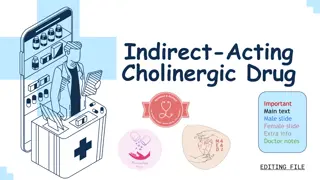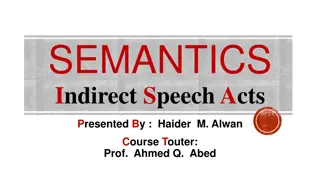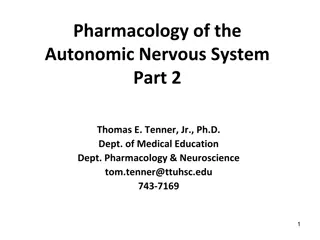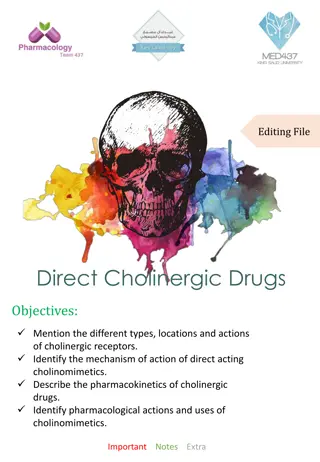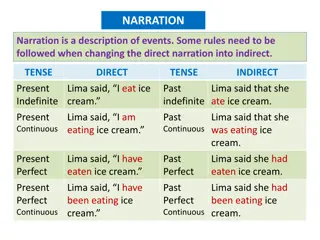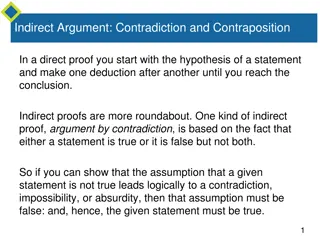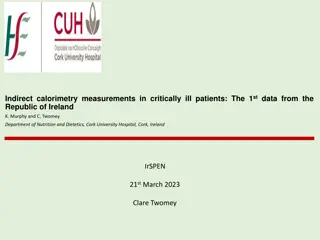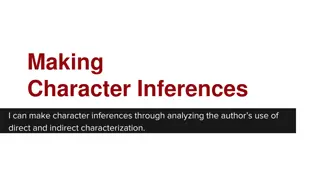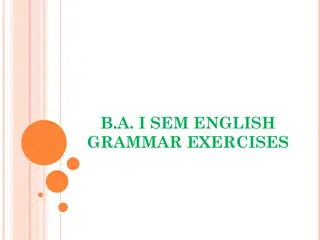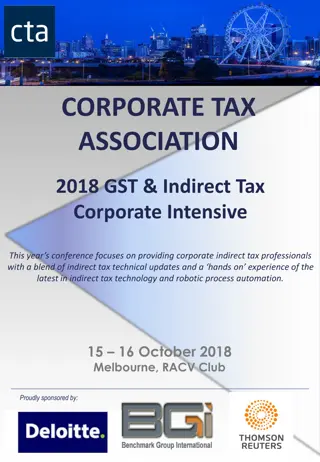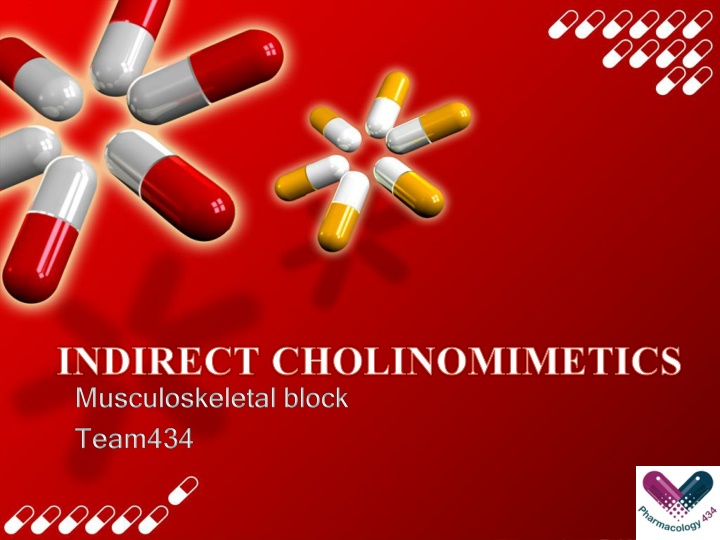
Indirect Cholinomimetics and Anticholinesterases
Learn about the classification, mechanism of action, kinetics, dynamics, and uses of indirect acting cholinomimetics, specifically anticholinesterases. Explore the adverse effects, contraindications, and treatment of organophosphates toxicity. Understand the pharmacological effects of anticholinesterases on muscarinic and nicotinic receptors, as well as their impact on the central nervous system. Discover the various types of anticholinesterases, their structure, and modes of action.
Download Presentation

Please find below an Image/Link to download the presentation.
The content on the website is provided AS IS for your information and personal use only. It may not be sold, licensed, or shared on other websites without obtaining consent from the author. If you encounter any issues during the download, it is possible that the publisher has removed the file from their server.
You are allowed to download the files provided on this website for personal or commercial use, subject to the condition that they are used lawfully. All files are the property of their respective owners.
The content on the website is provided AS IS for your information and personal use only. It may not be sold, licensed, or shared on other websites without obtaining consent from the author.
E N D
Presentation Transcript
What students should know: Classification of indirect acting cholinomimetics Mechanism of action, kinetics, dynamics and uses of anticholinesterases Adverse effects & contraindications of anticholinesterases Symptoms and treatment of organophosphates toxicity.
anticholinesterases Reversible anticholinesterases Irreversible anticholinesterases Short acting Intermediate acting Long acting Physostigmine Pyridostigmine Neostigmine Ecothiophate Isoflurophate edrophonium -alcohol All phosphates are lipid soluble except ecothiophate which is polar. All polar except physostigmine -forms weak hydrogen bond with cholinesterase -Phosphate esters -very long duration of action -form very stable covalent bond with cholinesterase -Carbamates esters -binds to two sites of cholinesterase enzyme
Indirect cholinomimetics (also called anticholinesterases) Anticholinesterases prevent hydrolysis of Ach by inhibiting acetyl cholinesterase thus increase Ach concentrations and actions at the cholinergic receptors (both nicotinic and muscarinic). Anticholinesterases are similar in structure to Ach so combine with cholinesterase instead of Ach Mechanism of action: Ach Nicotinic receptors Anticholinesterases Effects cholinesterase & Muscarinic receptors Choline + Acetate
Pharmacological effects of anticholinesterases ALL Anticholinesterases have muscarinic and nicotinic actions (N & M actions) and some have CNS effects (only lipid soluble drugs). Nicotinic actions CNS actions CNS actions (excitation, convulsion, respiratory failure, coma). only for lipid soluble anticholinesterases e.g. physostigmine & phosphate ester. (except ecothiophate that is polar). Neuromuscular junction Therapeutic dose: muscle contraction Toxic dose: relaxation or paralysis of skeletal muscles. Ganglia: stimulation of sympathetic and parasympathetic ganglia Adrenal medulla release of catecholamines (adrenaline, noradrenaline and dopamine).
Muscarinic actions Organs Organs Eye Cholinergic Cholinergic actions Contraction of circular muscle of iris (miosis)(M3) Contraction of ciliary muscles for near vision (M3) Decrease in intraocular pressure bradycardia (heart rate ) (M2) Release of NO (EDRF) Constriction of bronchial smooth muscles Increase bronchial secretion M3 Increased motility (peristalsis) Increased secretion Relaxation of sphincter M3 Contraction of muscles Relaxation of sphincter M3 Increase of sweat, saliva, lacrimal, bronchial, intestinal secretions M3 actions Heart endothelium Lung GIT Urinary bladder Exocrine glands
Reversible anticholinesterases Drug Actions Nicotinic & muscarinic (M, N) Kinetics (5-15 min.) -alcohol -Polar. Uses for diagnosis of myasthenia gravis (MG). NOT absorbed orally (given by injection). Edrophonium Nicotinic & muscarinic (M, N) Myasthenia gravis treatment Paralytic ileus Urinary retention Curare toxicity Myasthenia gravis treatment Pyridostigmine (Carbamate esters) 3-6 Polar Nicotinic & muscarinic (M, N) 4-8 polar Ambenonium (Carbamate esters)
Reversible anticholinesterases Drug Actions Nicotinic & muscarinic M, N (No CNS effect) Kinetics Uses 0.5-2hr Polar (Can be used orally) Myasthenia gravis treatment Paralytic ileus Urinary retention Curare toxicity (prominent on GIT & urinary tract). Glaucoma Atropine toxicity(atropine is anticholinergic drug) Neostigmine (Carbamate esters) (Quaternary ammonium comp.) Nicotinic & muscarinic M, N, & CNS 0.5-2hr Lipid soluble(non polar) (Good oral absorption) Physostigmine (Carbamate esters) (Tertiary ammonium comp.)
Indirect Cholinomimetics (Organophosphorous compounds) Organophosphates toxicity (Pesticide Toxicity) Mechanism Irreversible anticholinesterase Binds to cholinesterase by strong covalent bond. Have very long duration of action Aging make bond extremely stable All are highly lipid soluble except ecothiophate Used for glaucoma Sever bradycardia, hypotension. Bronchospasm. Increased GIT motility cramps & diarrhea. CNS effects convulsion, coma and respiratory failure. Initial twitching of skeletal muscles muscle weakness & paralysis.
Treatment of organophosphate toxicity Support respiration Cholinesterase reactivators (Oximes) Atropine (to block muscarinic actions & CNS effects). OXIMES Donepezil Anticholinesterase drugs. Given orally. used for treatment of dementia of Alzheimer s disease. Pralidoxime (PAM) Cholinesterase reactivator acts by regeneration of cholinesterase enzyme. reactivates recently inhibited enzymes before aging. Uses I.V. over 15-30 min for organophosphate intoxication.
Summary Antichollenistrases increase due to increase Ach. All Anticholinesterases have muscarinic and nicotinic actions (N & M actions) and some have CNS effects (only lipid soluble drugs). Anticholinesterases classified into tow classes: 1- Reversible: Short or intermediate action. 2- Irreversible is Long action. All the reversible Intermediate acting anticholinesterase are polar except physostigmine.
Summary The irreversible very long acting are phosphate esters (or Organophosphates) and all of them are lipid soluble except ecothiophate which is polar. Only lipid soluble drugs will have affect on the CNS e.g. Physostigmine. Organophosphates toxicity causes severe bradychardia and hypotension, effects on CNS manifest as coma and convulsion, it causes diarrhea due to increased GIT motility.
C:\Users\ \ Desktop\toon388.gif Click here to start QUIZ >>>



